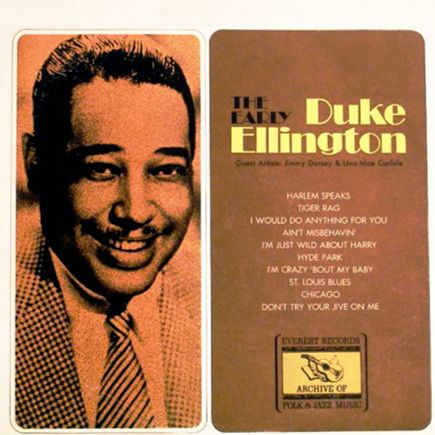Ain’t Misbehavin’: Fats Waller, Harlem et l’affirmation d’un art
Composée en 1929 par Fats Waller et Harry Brooks, sur des paroles d’Andy Razaf, Ain’t Misbehavin’ est bien plus qu’un simple succès musical: elle incarne l’esprit foisonnant de la Harlem Renaissance. Pensée comme numéro d’ouverture de la revue Connie’s Hot Chocolates, produite au Connie’s Inn — principal rival du Cotton Club —, elle célèbre l’inventivité afro-américaine dans un contexte de profonde effervescence artistique.
La chanson séduit par la combinaison d’une mélodie accrocheuse et d’harmonies sophistiquées, typiques du style stride dont Waller était l’un des maîtres incontestés. À travers un texte sur la fidélité amoureuse face aux tentations, Ain’t Misbehavin’ trouve une résonance universelle et intemporelle, renforçant son pouvoir d’attraction bien au-delà de son époque.
Son destin bascule lorsqu’un jeune Louis Armstrong est invité à doubler l’orchestre de Leroy Smith pour jouer au Hudson Theater. Son interprétation entre les actes, d’abord discrète depuis la fosse, devient rapidement le point culminant du spectacle. Un critique du New York Times souligne la puissance de ce moment, décrivant la chanson comme ‘synthétique, mais tout à fait agréable’. Armstrong est alors officiellement intégré à la distribution: sa prestation, désormais sur scène, propulse sa carrière vers une reconnaissance nationale.
L’élégance ellingtonienne en terre européenne
Le 13 juillet 1933, Duke Ellington enregistre à Londres une version magistrale de Ain’t Misbehavin’, immortalisant un moment clé de la première tournée européenne de son orchestre. Le contexte est remarquable: en pleine ascension, Ellington et ses musiciens sont reçus avec enthousiasme sur le Vieux Continent, où leur esthétique sophistiquée séduit un public curieux d’un jazz plus orchestré, moins exclusivement lié au dancing.
En condensant l’esprit du Harlem des années 1920 dans une forme orchestrale hautement stylisée, Ellington transforme Ain’t Misbehavin’ en une œuvre de concert.
L’enregistrement témoigne de cette ambition artistique. Ellington signe un arrangement ciselé, mettant en valeur la richesse de sa palette sonore. Les trois trompettistes — Freddy Jenkins, Arthur Whetsol et Cootie Williams — alternent finesse, lyrisme et éclats, tandis que les trombonistes Lawrence Brown, Joe ‘Tricky Sam’ Nanton et Juan Tizol tissent un tissu harmonique dense et nuancé.
La section des saxophones, portée par Johnny Hodges, Otto Hardwick et Harry Carney, incarne la signature sonore ellingtonienne: souplesse, chaleur, expressivité. La rythmique, assurée par Fred Guy (guitare), Wellman Braud (basse) et Sonny Greer (batterie), offre un soutien élégant, tout en légèreté et en swing contenu.
Ain’t Misbehavin’: Fats Waller, Harlem y la afirmación de un arte
Compuesta en 1929 por Fats Waller y Harry Brooks, con letra de Andy Razaf, Ain’t Misbehavin’ es mucho más que un éxito musical: encarna el espíritu vibrante del Renacimiento de Harlem. Concebida como número de apertura de la revista Connie’s Hot Chocolates, producida en el Connie’s Inn — principal competidor del Cotton Club —, celebra la inventiva afroamericana en un momento de intensa efervescencia artística.
La canción destaca por su combinación de melodía pegadiza y armonías sofisticadas, características del estilo stride que Waller dominaba con maestría. Su letra, centrada en la fidelidad amorosa frente a las tentaciones, le confiere una resonancia universal y atemporal, lo que ha contribuido a consolidar su atractivo a lo largo de las décadas.
Su destino cambia cuando un joven Louis Armstrong es invitado a reforzar la orquesta de Leroy Smith en el Hudson Theater. Su interpretación durante los intermedios, inicialmente desde el foso, se convierte pronto en el punto culminante del espectáculo. Un crítico del New York Times destacó la fuerza de ese momento, describiendo la canción como “sintética, pero francamente agradable”. Armstrong es entonces integrado oficialmente en el reparto, y su actuación sobre el escenario lanza su carrera hacia el reconocimiento nacional.
La elegancia ellingtoniana en suelo europeo
El 13 de julio de 1933, Duke Ellington grabó en Londres una magistral versión de Ain’t Misbehavin’, inmortalizando un momento clave de la primera gira europea de su orquesta. El contexto es notable: en pleno ascenso, Ellington y sus músicos fueron recibidos con entusiasmo en el Viejo Continente, donde su estética sofisticada sedujo a un público ávido de un jazz más orquestal, menos vinculado al baile.
Al condensar el espíritu del Harlem de los años veinte en una forma orquestal altamente estilizada, Ellington convierte Ain’t Misbehavin’ en una verdadera obra de concierto.
La grabación da cuenta de esta ambición artística. Ellington firma un arreglo meticuloso que realza la riqueza de su paleta sonora. Los tres trompetistas —Freddy Jenkins, Arthur Whetsol y Cootie Williams— alternan sutileza, lirismo y brillo, mientras que los trombonistas Lawrence Brown, Joe ‘Tricky Sam’ Nanton y Juan Tizol tejen una textura armónica densa y matizada.
La sección de saxofones, liderada por Johnny Hodges, Otto Hardwick y Harry Carney, encarna la firma sonora ellingtoniana: flexibilidad, calidez y expresividad. La rítmica, a cargo de Fred Guy (guitarra), Wellman Braud (contrabajo) y Sonny Greer (batería), ofrece un acompañamiento elegante, entre ligereza y swing contenido.
Ain’t Misbehavin’: Fats Waller, Harlem e l’affermazione di un’arte
Composta nel 1929 da Fats Waller e Harry Brooks, con testo di Andy Razaf, Ain’t Misbehavin’ è molto più di un successo musicale: rappresenta lo spirito vivace della Harlem Renaissance. Pensata come apertura della rivista Connie’s Hot Chocolates, andata in scena al Connie’s Inn — principale concorrente del Cotton Club —, celebra l’ingegno afroamericano in un contesto di grande fermento artistico.
Il brano conquista per l’efficace combinazione tra melodia accattivante e armonie raffinate, tipiche dello stile stride che Waller padroneggiava in modo magistrale. Il testo, incentrato sulla fedeltà amorosa nonostante le tentazioni, le conferisce una forza espressiva universale e senza tempo, che ne ha garantito la longevità.
La svolta arriva quando un giovane Louis Armstrong viene invitato a rinforzare l’orchestra di Leroy Smith al Hudson Theater. La sua esecuzione tra un atto e l’altro, inizialmente dal golfo mistico, diventa presto il momento clou dello spettacolo. Un critico del New York Times sottolineò la potenza di quel passaggio, definendo la canzone “sintetica, ma assolutamente gradevole”. Armstrong viene così inserito ufficialmente nel cast, e la sua performance sul palco segna l’inizio della sua ascesa a livello nazionale.
L’eleganza ellingtoniana in terra europea
Il 13 luglio 1933, Duke Ellington registra a Londra una magistrale versione di Ain’t Misbehavin’, immortalando un momento chiave della sua prima tournée europea. Il contesto è significativo: in piena ascesa, Ellington e i suoi musicisti vengono accolti con entusiasmo nel Vecchio Continente, dove la loro estetica sofisticata conquista un pubblico curioso di un jazz più orchestrale e meno legato esclusivamente al ballo.
Racchiudendo lo spirito dell’Harlem degli anni Venti in una forma orchestrale altamente stilizzata, Ellington trasforma Ain’t Misbehavin’ in un’opera da concerto.
La registrazione riflette questa ambizione artistica. Ellington firma un arrangiamento cesellato, che valorizza la ricchezza della sua tavolozza sonora. I tre trombettisti —Freddy Jenkins, Arthur Whetsol e Cootie Williams— alternano finezza, lirismo e brillantezza, mentre i trombonisti Lawrence Brown, Joe ‘Tricky Sam’ Nanton e Juan Tizol creano una trama armonica densa e sfumata.
La sezione dei sassofoni, con Johnny Hodges, Otto Hardwick e Harry Carney, incarna la firma sonora ellingtoniana: flessibilità, calore ed espressività. La ritmica, affidata a Fred Guy (chitarra), Wellman Braud (contrabbasso) e Sonny Greer (batteria), offre un sostegno elegante, tra leggerezza e swing trattenuto.
Ain’t Misbehavin’: Fats Waller, Harlem, and the assertion of an art form
Composed in 1929 by Fats Waller and Harry Brooks, with lyrics by Andy Razaf, Ain’t Misbehavin’ is far more than a popular hit — it captures the dynamic spirit of the Harlem Renaissance. Originally conceived as the opening number for the revue Connie’s Hot Chocolates, staged at Connie’s Inn — the main rival of the Cotton Club — the piece celebrates African American creativity during a time of profound artistic vitality.
The song captivates through its blend of catchy melody and sophisticated harmonies, hallmarks of the stride piano style that Waller mastered like few others. Its lyrics, centered on romantic fidelity in the face of temptation, carry a timeless and universal resonance, lending the piece lasting relevance.
Its trajectory shifted dramatically when a young Louis Armstrong was asked to reinforce Leroy Smith’s orchestra at the Hudson Theater. His intermission performance — initially delivered from the orchestra pit — quickly became the highlight of the evening. A New York Times critic noted the impact of the moment, calling the song “synthetic but thoroughly enjoyable.” Armstrong was soon officially added to the cast, and his stage performance marked the beginning of his rise to national fame.
Ellingtonian elegance on european soil
On July 13, 1933, Duke Ellington recorded a masterful version of Ain’t Misbehavin’ in London, capturing a defining moment in his orchestra’s first European tour. The context is remarkable: at the height of his rise, Ellington and his musicians were warmly welcomed on the Continent, where their refined aesthetic appealed to audiences eager for a more orchestrated jazz, less strictly tied to dancing.
By distilling the spirit of 1920s Harlem into a highly stylized orchestral form, Ellington elevates Ain’t Misbehavin’ into a concert piece.
The recording reflects this artistic ambition. Ellington delivers a finely crafted arrangement that highlights the richness of his sonic palette. The three trumpeters —Freddy Jenkins, Arthur Whetsol, and Cootie Williams— alternate between subtlety, lyricism, and brilliance, while trombonists Lawrence Brown, Joe ‘Tricky Sam’ Nanton, and Juan Tizol weave a dense, nuanced harmonic fabric.
The saxophone section, led by Johnny Hodges, Otto Hardwick, and Harry Carney, embodies the Ellingtonian signature: flexibility, warmth, and expressiveness. The rhythm section —Fred Guy (guitar), Wellman Braud (bass), and Sonny Greer (drums)— provides elegant support, blending lightness with restrained swing.
Autres articles – Otros artículos – Altri articoli
Louis ARMSTRONG (04.08.1901–06.07.1971)
Barney BIGARD (03.03.1906–27.06.1980)
Lawrence BROWN (03.08.1907–05.09.1988)
Harry CARNEY (01.04.1910–08.10.1974)
Duke ELLINGTON (29.04.1899–24.05.1974)
Sonny GREER (13.12.1895–23.03.1982)
Johnny HODGES (25.07.1907–11.05.1970)
Joe « Tricky Sam » NANTON (01.02.1904–20.07.1946)
Juan TIZOL (22.01.1900–23.04.1984)
Ain’t Misbehavin’–19.07.1929–Louis ARMSTRONG
Ain’t Misbehavin’–02.08.1929–Fats WALLER
Ain’t Misbehavin’–09.07.1935–Paul WHITEMAN & Jack TEAGARDEN
Ain’t Misbehavin’–03.03.1937–Jimmy MUNDY
Ain’t Misbehavin’–22.04.1937–Django REINHARDT
Ain’t Misbehavin’–xx.05-06.1938–Jelly Roll MORTON
Ain’t Misbehavin’–xx.xx.1944–Art TATUM
Ain’t Misbehavin’–18.05.1950–Sarah VAUGHAN
Ain’t Misbehavin’–xx.10.1955–Johnny HARTMAN


